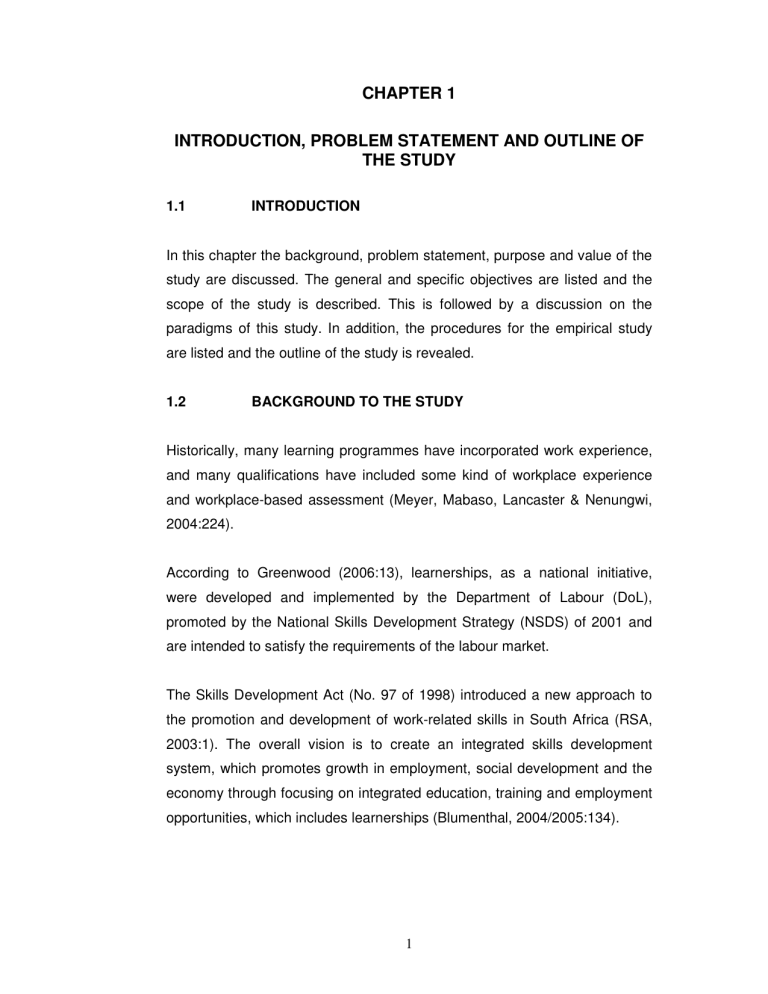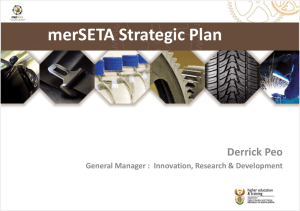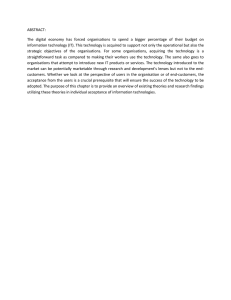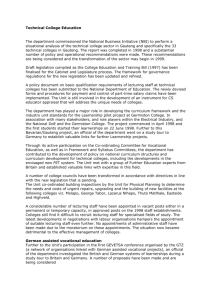chapter 1 introduction, problem statement and outline of the study

CHAPTER 1
INTRODUCTION, PROBLEM STATEMENT AND OUTLINE OF
THE STUDY
1.1 INTRODUCTION
In this chapter the background, problem statement, purpose and value of the study are discussed. The general and specific objectives are listed and the scope of the study is described. This is followed by a discussion on the paradigms of this study. In addition, the procedures for the empirical study are listed and the outline of the study is revealed.
1.2 BACKGROUND TO THE STUDY
Historically, many learning programmes have incorporated work experience, and many qualifications have included some kind of workplace experience and workplace-based assessment (Meyer, Mabaso, Lancaster & Nenungwi,
2004:224).
According to Greenwood (2006:13), learnerships, as a national initiative, were developed and implemented by the Department of Labour (DoL), promoted by the National Skills Development Strategy (NSDS) of 2001 and are intended to satisfy the requirements of the labour market.
The Skills Development Act (No. 97 of 1998) introduced a new approach to the promotion and development of work-related skills in South Africa (RSA,
2003:1). The overall vision is to create an integrated skills development system, which promotes growth in employment, social development and the economy through focusing on integrated education, training and employment opportunities, which includes learnerships (Blumenthal, 2004/2005:134).
1
Robbins, Odendaal and Roodt (2003:358) view the concept of learnership as an important component of the South African NSDS and indicate that similar to traditional apprenticeships, learnerships are on-the-job training programmes. Unlike apprenticeships, learnerships are not limited to technical
‘blue-collar’ trades and younger people entering the employment world.
1.3 PROBLEM STATEMENT
According to Du Plessis, Fouché and Van Wyk (2002:179), a skilled workforce is an essential requirement for the growth of the South African economy. Coetzer (2006:25) notes that South Africa’s economy is growing faster than its infrastructure and skills base can cope with. Therefore, training is becoming increasingly important, especially with regards to critical technical skills such as engineering.
The Skills Development Act (No. 97 of 1998) was passed to redress skills shortages. This Act is supported by the South African Qualifications Authority
Act (No. 50 of 1995), the Skills Levies Act (No. 9 of 1999), the National
Qualifications Framework (NQF), the established Sector Education and
Training Authorities (SETAs), together with other legislation (RSA, 2003:1-2).
The SETAs are responsible for learnership programmes and use discretionary funds, drawn from levy income, to achieve their sector priorities
(Sunday Times, 2004:1).
With effect from 1 April 2001 almost all South African employers pay a skills development levy of one percent per remuneration cost towards skills development levies. Of these levies, 20 percent is paid into the National
Skills Fund (NSF). Funding from this source is used to increase education and training opportunities, including learnerships (Mercorio & Mercorio,
2001:14-15).
2
Freeman (2003:8) reports that businesses have embraced the concept of workplace learnerships. While acceptance of learnerships has occurred slowly, it has occurred steadily enough to convince even the sceptics that this type of learning is the way forward.
However, some people perceive learnerships as being burdensome, placing significant obligations and requirements on the resources of businesses
(Business Day, 2003:3). Others feel that learnerships hold promise in a number of ways, providing that obstacles like the SETAs’ imperfect administrative systems, inadequate support systems in education and complex stakeholder relationship can be overcome (Karlsson & Berger,
2006:62).
Key skills shortages, coupled with high levels of unemployment and
“unemployability” are well documented in South Africa. Thus, not only is there an impact on employment, but also on the type of skills and human capital required across the sectors (Babb & Meyer, 2005:2).
Babb and Meyer (2005:198) further state that from South African case studies on learnerships, the following issues relating to learnerships need to be addressed:
•
declining levels of employment and skills shortages with relation to the labour force in South Africa
•
distributing of income on an equal basis
•
access to education, training and employment opportunities
• the effects of race, gender and geographical location on advancement opportunities.
According to Naidoo (2003:3), learnerships, which are meant to reduce the skills shortage, are not addressing this shortages problem. This is mainly because the SETAs have failed to communicate the benefits of learnerships to companies aggressively.
3
1.4 PURPOSE OF THE STUDY
Based on the above problem statement, the purpose of this research is to determine organisational perspectives of learnerships within the
Manufacturing, Engineering and Related Services Education and Training
Authority (MERSETA) organisations in the Sedibeng district municipal area.
Perspectives are defined as an individual way of regarding a situation, for example one influenced by personal experience or considerations
(Chambers, 1999:1034).
1.5 VALUE OF THE STUDY
This research serves as a tool to investigate certain elements of uncertainty regarding learnerships. The importance of the study lies in the fact that no study of this nature has been conducted in Sedibeng district municipal area to date.
The study seeks to establish whether learnerships are beneficial to
MERSETA organisations in the Sedibeng district municipal area.
The findings should assist local organisations in:
•
planning their development and training programmes
•
understanding the concept of learnerships
• determining what to expect from implemented learnerships
•
sourcing staff
Findings should also provide important feedback to the Department of Labour and the MERSETA. These findings can assist with the future planning and implementation of learnerships, as well as other training programmes.
4
1.6
1.6.1
RESEARCH OBJECTIVES
General objective
• The general objective of this study is to determine organisational perspectives of learnerships within certain MERSETA organisations in the
Sedibeng district municipal area.
1.6.2 Specific objectives
The specific theoretical objectives of this study are to:
• conduct a literature study regarding the origin of learnerships
•
carry out a literature review regarding organisational perspectives towards learnerships.
The specific empirical objective of this study is to:
•
evaluate organisational perspectives towards learnerships in manufacturing, engineering and metal organisations that fall under the
MERSETA within the Sedibeng municipal district area.
1.7 RESEARCH METHODOLOGY
The two main research methods that will be used to achieve the objectives of this study are outlined in Figure 1. Each method is briefly described in the following sections.
In most cases the first phase of postgraduate research methodology is to conduct a review of the literature that is relevant to the research area (a nonempirical study). Hart (1998:13) defines a literature study as: “…the
5
selection of available documents (both published and unpublished) on the topic, which contain information, ideas, data and evidence written from a particular standpoint to fulfil certain aims or express a certain view on the nature of the topic and how it is to be investigated, and the effective evaluation of these documents in relation to the research being proposed”.
( Source: Babbie & Mouton, 2003:78)
Figure 1: Research methods
6
Welman and Kruger (2001:35) call attention to the fact that the literature review should not consist of a mere compilation of separate, isolated summaries of the individual studies of previous researchers. Rather, the researcher should clearly show how previous studies relate to one another and how the proposed research ties in with these studies - this is often referred to as the ‘golden thread’.
Phase 1 of this research focuses on a review of the relevant literature, as outlined in the theoretical objectives of the study discussed in Section 1.6.2.
Sources were obtained from the following databases:
•
SABINET
• EBSCO HOST
•
Internet
• Textbooks
•
Reports
•
•
•
•
•
EMERALD MCB
LEXIS NEXIS
Various library catalogues
Journals/Periodicals
Conference proceedings
The second phase of postgraduate research is through an empirical study in order to provide insight and understanding of the basic methodological techniques and methods used during the study, how they were applied and what purpose they played in obtaining, analysing and interpreting the relevant data. According to Cooper and Schindler (1998:26), an empiricist attempts to describe, explain and make predictions through observation.
Phase 2 of this research comprises the empirical investigation applied to attain the empirical objectives of the study, as outlined in Section 1.6.2. The empirical study includes a description of the research design, the target population, the selection of the sample, the measuring instruments utilised and the methods of statistical analysis employed.
7
1.7.1 Research design
In this study, emphasis is placed on both quantitative and qualitative research. The two methods compliment each other in that quantitative research focuses on precise and general results, while qualitative research provides an in-depth perspective from the sample population’s point of view, especially with regard to those variables that cannot be proven via statistical analysis (Blaxter, Hughes & Malcolm, 2006:64&65, Kumar, 2005:12-14;
Leedy & Ormrod, 2005:94&95; Malhotra, 1999:148).
According to Blaxter, Hughes and Malcolm (2006:64-67) as well as Cooper and Schindler (1998:134), both qualitative and quantitative methods may be used appropriately within any research paradigm. Qualitative researchers are interested in answering ‘why’ questions and are not prepared to simply accept the quantitative answers. When placed alongside qualitative evidence, quantitative evidence is both clear and powerful.
This study aims to determine the current situation with regard to the perspectives towards learnerships via a literature review and questionnaires, thus utilising both of the above-mentioned research methods.
1.7.2 Target population
The target population consists of organisations located in the industrial areas of Vanderbijlpark, Vereeniging and Meyerton, within the Sedibeng district municipal area, formerly part of the Vaal Triangle (Figure 2). These municipalities are now known as Emfuleni, Lesedi and Midvaal local municipalities respectively (Emfuleni Local Municipality, 2008:2; Slabbert,
2005:6-7).
8
( Source : The Vaal Meander, 2006:16)
Figure 2: Map of Vanderbijlpark, Vereeniging and Meyerton
This research project’s population consists of a total of approximately 300 (N
= 300) relevant organisations within the Sedibeng district municipal area, which fall under the MERSETA and are situated in the industrial areas of
Vanderbijlpark, Vereeniging and Meyerton (Slabbert, 2005:6-7; Emfuleni
Local Municipality, 2008:2). During 2006, databases of organisations within the Sedibeng district municipal area were obtained from the local Emfuleni
Municipality Information services and the Co-operative Education
Department of the Vaal University of Technology.
Of these identified organisations, 150 (n = 150) agreed to take part in the research project.
9
Several organisations indicated that their head offices are not situated within the Sedibeng district municipal area and, therefore, the researcher anticipated the elicitation of some responses from outside the Sedibeng district municipal area for incorporation in the data responses.
1.7.3 Selection of the sample
A sample of 150 small, medium and large organisations will be included in the research project. These organisations were drawn from databases obtained from Emfuleni Municipality and the Co-operative Education
Department of the Vaal University of Technology, during 2006.
A non-probability sampling technique in the form of purposive sampling, will be used in the study. Kumar (2005:179) indicates that purposive sampling is useful when constructing a historical reality, describing a phenomenon or developing something about which only a little is known. This description falls within the scope of the study and, as such, purposive sampling will be used to obtain a representative selection of respondents to participate in the survey.
According to Welman and Kruger (2001:63), purposive sampling obtains units of analysis in such a manner that the sample obtained may be regarded as being representative of the relevant population.
1.7.4 Measuring instrument
Primary data will be generated by means of a questionnaire, designed by the researcher, to elicit perspectives of learnerships within organisations.
Surveys, using questionnaires, are perhaps the most widely-used datagathering technique in business and can be used to measure issues that are crucial to the management and development of human resources such, as
10
behaviour, attitudes, beliefs, opinions, characteristics and expectations
(Anderson, 2004:208).
The questionnaire consists of five sections:
•
Section A covers company background, that is: area situated; main focus; ownership; type of organisation; size, position of person completing the questionnaire; utilisation of learnerships and membership of the
MERSETA.
•
Section B was designed to obtain information relating to these organisations’ perspectives regarding learnerships, including aspects such as costs, cultures, benefits, advantages, disadvantages, barriers, constraints and support structures.
• Section C focuses on learnership levels within the NQF and time management.
•
Section D concentrates on contact and assistance from MERSETA as a support structure.
•
Section E was designed to determine the skills development and training requirements of the relevant organisations.
1.7.5 Methods of statistical analysis
Descriptive statistics will initially be undertaken to analyse the composition of the sample.
11
The Statistical Package for Social Sciences (SPSS) version 15.0 for
Windows will be used to process the raw data obtained from the questionnaires.
Quantitative analysis of the question responses obtained from the questionnaire will be summarised, portrayed and analysed on a statistical basis in order to offer the researcher the opportunity to analyse the responses and identify whether the results are skewed (Heather, 2003:59).
The following statistical analyses will be undertaken:
•
A pilot study will be conducted to establish content validity.
•
Face validity will be established through the circulation of the questionnaire to ten pilot respondents .
•
The researcher will check for skewness of the items in Section B, of the questionnaire, to determine whether the normality assumptions were violated or not.
•
Internal consistency will be measured under reliability by calculating
Cronbach’s Alpha coefficient ( α ).
•
Frequency analysis and comparison using the Mann-Whitney U test , based on a probability value of p >0.05, p >0.01 and p >0.10 will be done to determine statistically significant differences.
•
The Spearman’s rank correlation coefficient (r s
) will be used to obtain a measure of linear association between variables in Section B of the questionnaire.
12
1.8 OUTLINE OF THE STUDY
Figure 3 aids in facilitating understanding of the outline of this study.
Problem statement
Purpose of the study
Value of the study
Skills shortages in S.A.
Legislation
Learnership overview
Research objectives
Target population
Research design
Hypotheses
Results
Chapter 1 - Introduction
Chapter 2 – Literature study
Chapter 3 – Methodology
Chapter 4 – Results
Research objectives
Research methodology
Scope of the study
Support structures
Role players in learnerships
The MERSETA
Measuring instruments
Analysis
Reliability and validity
Findings
Conclusions
Overview of study
Conclusions of the study
Recommendations
Chapter 5 – Conclusions and recommendations
Figure 3: Outline of the study
Limitations of the study
Future research
Value of the research
1.9 SUMMARY
This study concentrates on determining organisational perspectives of learnerships within certain MERSETA organisations in the Sedibeng district municipal area. The focus of the study is to establish whether learnerships are beneficial to the providers thereof.
In this chapter, the problem statement was discussed in order to motivate the reason for this study. Research questions and the general and specific objectives were addressed. A brief outline of the study was also provided.
13
Chapter 2 presents a literature study on learnerships and applicable legislation in the South African context. Concept clarification of learnerships, components, benefits, role players and implementation are discussed. The chapter concludes with the barriers and challenges facing learnership implementation.
14






